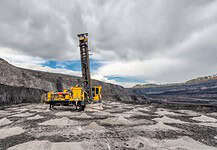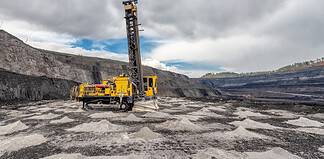After successfully completing its pilot study at Lake Wells in January, Australian Potash is gearing up to begin producing 150,000 tonnes of sulphate of potash by 2020. Image: Australian Potash
BY GERARD MCARTNEY
AUSTRALIAN Potash successfully extracted 65kg of 98 per cent purity sulphate of potash (SOP) from its Lake Wells pilot processing facility on 22 January.
First production at a pilot level marked a number of important milestones for Australian Potash; a proven processing pathway to delivering a high-grade SOP product, and the gratification of being the first company in Australia to successfully use the field evaporative method.
According to Australian Potash managing director Matt Shackleton, the field evaporative method lets nature do all the hard work by pumping brine into salt lakes.
And compared to the more commonly used Mannheim method that chemically treats muriate of potash (MOP) to create SOP and leaves behind sulphuric acid, the field evaporative method was far simpler and required fewer chemicals.
“The solar salt method is a much lower cost, organic method; we don’t introduce any deleterious elements, it is low energy and it is a much more economic process, particularly in Australia,” Mr Shackleton told The Australian Mining Review.
Australian Potash sunk its production bores into a deep paleo channel that ran under Lake Wells to get its brine.
“We were fortunate in Lake Wells. Once we sunk the production bores into the paleo channel system, the water came out at a rate of knots that was unexpected,” he said.
The production bores at Lake Wells began pumping water at up to 34 litres per second; more than double the anticipated rate.
Mr Shackleton said this could be attributed to the age of the brine itself that was predicted to be 45 million years old but, after carbon dating, was estimated at closer to 200 million years old.
“This produced a very simple and pure brine. It is not confused by deleterious elements, it doesn’t have calcium or carbonate concentrate, and that’s what allowed us to make such high quality SOP,” he said.
Unlike projects owned by some of its peers, the pressure provided by the Lake Wells paleo channel spared the company from digging an extensive and expensive trenching system that would have involved more than 200km of trenches.
Once the brine was pumping out of the bores and into the evaporating ponds, it was a matter of waiting till the brine turned into salt before it could be taken to the processing plant.
“We were always confident we could make sulphate of potash, but what did surprise us was that we made such a good quality SOP,” Mr Shackleton said.
An International Shortage
Sulphate of potash was a standard ingredient found in almost every broad-acre agricultural fertiliser.
As a source of soluble potassium, along with phosphorous and nitrogen, SOP was one of the three primary ingredients plants need to grow.
The potassium in SOP was fundamental to the development of strong plants— it thickened their cell walls and developed a resistance to rot in the plants.
This demand for fresh food was coupled with the Chinese Government’s ambitious campaign to heat millions of homes with natural gas, which cut its gas-based fertiliser operating rates to 15 per cent.
These conditions left international fertiliser producers short of supplies, while the demand and price of fertilisers has been steadily rising.
Australian Potash said it had sent samples to potential Chinese partners, Sino-Agri Holdings and Hubei- Agri, to conduct tests, and had signed non-binding agreements with Sino-Agri Holding.
The agreement envisaged sales volumes of up to 100,000 tonnes per annum, or 30 per cent of the estimated production from stage two of Lake Wells project once it was up and running.
Australian Potash had also partnered with The University of Western Australia’s Department of Agriculture and Environmental Science department, which had been conducting experiments on WA farming soil.
“They [UWA] have identified that WA soil is not only deficient in SOP, but that it is critically depleted—it’s almost the last few heart beats for a lot of this soil because it hasn’t had potassium for so long,” Mr Shackleton said.
“We’re working with several of the State’s largest farming groups who are connected to the farmers who are our end users.
“We’re hoping to show them that not only is SOP better than MOP, we actually want to give them the numbers by which it is better.
“We’re doing greenhouse and broad acre testing, analysing the yield, quality and soil biology because we want to meet them and tell them how much it is going to cost.
“WA is Australia’s largest user of potassium because it produces the most grain, there’s a massive untapped market here.”
“It is not confused by deleterious elements, it doesn’t have calcium or carbonate concentrate, and that’s what allowed us to make such high quality SOP.”
2019 Outlook
On 11 February, Australian Potash announced it had raised the required $5.2 million for general working capital to complete its Definitive Feasibility Study (DFS) by the end of the year.
If the company stayed on track for its project deadline, it will be operational and producing SOP by the end of 2020.
The Lake Wells gold project was also ramping up activities.
In the December quarter, the company entered into a $7 million earn-in and joint venture agreement with St Barbara covering tenure at the project.
Under the joint venture, St Barbara would pay an initial $1.25 million followed by $1.75 million to put towards exploration in the first year.
Subsequent to the remaining payments, St Barbara could earn a 70 per cent interest in the gold project.
However, Australian Potash would retain 100 per cent of the potash and associated mineral rights.
“We are looking forward to building our relationship with the St Barbara team,” Mr Shackleton said.
“I am confident that we now have the right people, right companies and right project area in place to generate some significant success at what is one of the State’s very prospective and important mineral regions.”








































